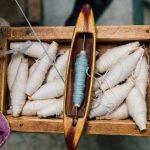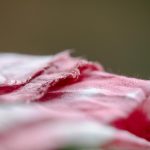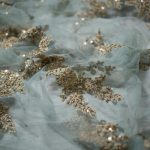When it comes to dyeing gossamer fabric, you'll find that its delicate nature presents both challenges and unique opportunities. You might notice how different fiber contents—like silk versus synthetic materials—affect color absorption, leading to surprisingly rich or vivid results. To maximize your dyeing success, you'll need to consider techniques and temperature carefully, as handling is crucial. But what exactly can go wrong if you're not meticulous? Understanding these aspects can truly transform your projects, prompting you to explore the nuances that define the dyeing journey of gossamer.
Table of Contents
Overview of Gossamer Fabric
Gossamer fabric is renowned for its delicate texture and lightweight feel, making it a favorite choice for elegant garments and intricate designs. You'll find it commonly used in evening gowns, bridal wear, and unique costumes, where finesse is key. This sheer material is often woven from silk, nylon, or polyester, contributing to its ethereal quality.
When you handle gossamer, you'll notice its soft drape and subtle sheen, which add depth and sophistication to any creation. It's essential to understand that while gossamer may be beautiful, it requires careful handling due to its fragile nature. Avoid rough treatment, as it can easily snag or tear.
In terms of versatility, you can use gossamer in layered designs, combining it with other fabrics to create a dynamic visual effect. While it shines on its own, pairing it can enhance both structure and aesthetic appeal. When designing with gossamer, consider the weight and flow to achieve the desired silhouette.
Ultimately, this fabric's delicate charm can elevate your creations, making them stand out in a crowd, but mastering its unique qualities is key to ensuring longevity and beauty.
Color Absorption Characteristics
Understanding the color absorption characteristics of gossamer is vital for achieving the desired hue and vibrancy in your designs. Gossamer's lightweight and delicate structure influences how it interacts with dyes. You'll notice that this fabric tends to absorb colors differently than heavier textiles.
The key factor here is gossamer's fiber content, which often includes silk or synthetic materials. These fibers can absorb dye by allowing it to penetrate their surface. However, the absorption rate can vary significantly depending on the specific dye used.
Natural dyes generally bond well with gossamer, producing rich, organic shades, while synthetic dyes may offer a brighter palette but could require special preparation.
You should also take into account the dyeing process. Pre-treating the fabric can enhance absorption, ensuring even color distribution. Additionally, the temperature during dyeing plays a crucial role; higher temperatures generally increase dye uptake.
Recommended Dyeing Techniques
To achieve vibrant and consistent results when dyeing gossamer, it's essential to select the right techniques tailored to its delicate nature. The fragile fibers of gossamer require a gentle approach to prevent damage while ensuring a rich color uptake.
Here are some recommended dyeing techniques you should consider:
- Use Cold Water Dyes: Opt for dyes specifically designed for cold water application to preserve gossamer's integrity.
- Pre-soak the Fabric: Before dyeing, lightly soak the fabric in lukewarm water to prepare it, ensuring even dye absorption.
- Gentle Stirring: When mixing the dye, ensure you stir gently to avoid agitating the fabric too much, which can cause snags.
Factors Affecting Dyeing Results
Successful dyeing results can vary significantly due to several factors that influence how the fabric interacts with dye. Understanding these factors can help you achieve the desired color and finish on gossamer fabric.
One key factor is the type of dye you choose; different dyes interact with fibers in unique ways. The temperature of the dye bath is also crucial; higher temperatures promote better dye absorption but can damage delicate fabrics. Additionally, the fabric's pre-treatment plays a huge role; properly preparing gossamer ensures even color distribution.
Here's a summary of these factors:
| Factor | Influence on Dyeing |
|---|---|
| Type of Dye | Determines color fidelity and intensity. |
| Dye Bath Temperature | Higher temperatures can enhance absorption but may damage fabric. |
| Fabric Pre-treatment | Ensures even color and reduces streaking. |
Maintenance of Dyed Gossamer
Maintaining dyed gossamer requires careful attention to ensure the vibrant colors remain intact and the delicate fabric stays in good condition. To achieve this, you'll need to follow some simple care guidelines that will keep your gossamer looking fresh and beautiful.
Gentle Hand Washing: Always wash your gossamer by hand using cold water and a mild detergent. Avoid twisting or wringing the fabric, as it can lose its shape and vibrancy.
Air Drying: Lay the gossamer flat on a clean towel to dry. Steer clear of direct sunlight, which can fade the colors over time.
Proper Storage: Store your dyed gossamer in a cool, dry place, ideally in a cotton bag or wrapped in acid-free tissue to prevent any fabric damage.
Avoid Harsh Chemicals: Don't use bleach or fabric softeners, as they can compromise the dye and weaken the fibers.
Frequently Asked Questions
What Types of Dyes Are Best for Gossamer Fabrics?
For gossamer fabrics, you're best off using acid dyes or fiber-reactive dyes. These options soak in well, providing vibrant colors without damaging the delicate texture. Always test on a small sample first to ensure compatibility.
Can Gossamer Be Dyed Multiple Colors at Once?
Yes, you can dye gossamer multiple colors at once. Just be careful with dye application techniques like tie-dye or batik, as they allow you to achieve vibrant, contrasting hues without compromising the fabric's delicate nature.
How Does Gossamer React to Synthetic Versus Natural Dyes?
When you use synthetic dyes, gossamer tends to absorb vibrant colors but may lose some softness. In contrast, natural dyes usually yield more muted tones while maintaining its delicate texture, ensuring a more subtle finish.
Are There Any Pre-Dyeing Preparations Needed for Gossamer?
Before dyeing gossamer, you'd want to wash it gently to remove any dirt or oils. Pre-soaking in a mild fixative can also help the dye adhere better, ensuring vibrant and lasting colors once you dye it.
How Do Different Fabric Blends Affect the Dyeing Process of Gossamer?
Different fabric blends can significantly impact the dyeing process. You'll notice that the composition affects absorption rates and color vibrancy, so experimenting with various blends helps you achieve the desired results in your dyeing projects.
- How Does Ring Spun Cotton Affect Garment Fit and Shape Retention? - August 13, 2024
- What Are the Challenges in Producing Ring Spun Cotton? - August 13, 2024
- Is Ring Spun Cotton Suitable for Plus-Size Clothing? - August 13, 2024







